AMPLIFY VOL. 38, NO. 2

The global community faces several interdependent challenges: decreases in biodiversity and rising levels of species extinction, climate change and its impacts on human and social systems, and global inequality and related socioeconomic impacts on vulnerable populations.
The Intergovernmental Panel on Climate Change (IPCC) “Climate Change and Land” report says scenarios to limit increases in mean global temperature are heavily reliant on land use.1 Unfortunately, nature and the biodiversity contained within (and the critical functions and services we derive from them) are under increasing pressure and in decline, resulting in approximately 1 million species being at risk of extinction.2
We are reliant on nature to an enormous degree, and if valued monetarily, the services/benefits it delivers would have vast sums attached to them. However, we continue to direct massive amounts of public and private finance to processes that negatively impact nature, amounting to US $7 trillion per year.3
In 1997, the landmark Nature paper “The Value of the World’s Ecosystem Services and Natural Capital” estimated that the value of services we receive from nature (known as “ecosystem services” or “nature’s contributions to people”) was $33 trillion, a figure that was widely derided as being either a gross under or overestimate.4 In 2020, research by the World Economic Forum attributed $44 trillion of economic value generation to nature and its services.5
Nature-based solutions (NbS) can be part of mitigating our interconnected global challenges. NbS are defined by the United Nations Environmental Programme (UNEP) as:
... actions to protect, conserve, restore, sustainably use, and manage natural or modified terrestrial, freshwater, coastal, and marine ecosystems which address social, economic, and environmental challenges effectively and adaptively, while simultaneously providing human well-being, ecosystem services, resilience, and biodiversity benefits.6
NbS are seen by the preeminent conservation organizations and many others as critical to achieving the goals of the Paris Agreement and the Kunming-Montreal Global Biodiversity Framework. However, only $200 billion flows to NbS annually, about a third of what’s needed to meet the goals and targets set out in those agreements/frameworks.7
Current Methodologies
Current methodologies and tools for understanding the benefits we receive from NbS tend to be overly simple or overly complex. Sometimes, benefits are evaluated at an extremely high level based primarily on the evaluator’s knowledge and experience. Other times, companies perform cost-benefit analyses that require applying highly detailed scientific and economic data to expensive models.
At both the screening and project levels, initiators may not be able to bear such expenses, and predominantly subjective determinations may lead to undervaluation, lack of transparency, and/or unintended negative consequences to ecologies and societies.8 This may contribute to underinvestment in NbS due to fear of failure and absence of quantified benefits from proposed or implemented interventions. In other cases, guidelines, instructions, and case studies for the valuation of specific solutions and scenarios are documented, but no method or tool for combining qualitative and quantitative evaluations is provided, so there are gaps in capturing realized benefits across natural, climate, and social systems.
Simplistic evaluations of NbS can obscure the range of both environmental and social opportunities they offer.9 A holistic approach is needed to tackle the problems of protecting and restoring biodiversity, mitigating and adapting to climate change, and supporting human well-being.
Screening NbS for their potential to deliver multiple benefits to nature and societies can address the challenges we face by integrating qualitative and quantitative measures and evidence.10 This article proposes a benefit-screening approach for evaluating and documenting the holistic value and impact potential of NbS that can be used in decision-making. Our methodology was developed by combining best practices and guidelines in NbS benefit-performance development indicators with ecosystem services and accounting.
We used a process-based approach to achieve integration, first constructing a representative model for the interaction of Earth systems (nature and biosphere) with societal systems that support human well-being. For the purposes of this article, the model takes the form of a framework for multi-criteria analysis (MCA). After the MCA framework was constructed, we developed quantitative and qualitative screening and scoring approaches. Our process is shown in Figure 1.
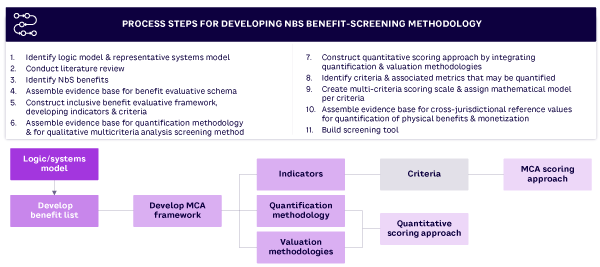
Our proposed framework includes indicators and criteria associated with six categories of benefit. The benefit categories, indicators, and criteria are based on a survey of literature performed in accordance with the process steps in Figure 1 and are organized in a hierarchical evaluative schema (see Figure 2).
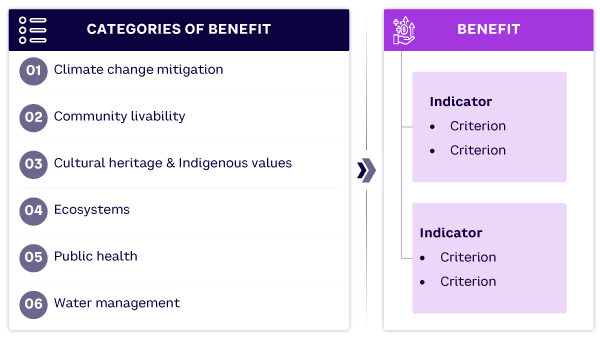
These categories function as the benefits list and are documented in an MCA framework. The detail associated with the assessment of these benefits provides transparency during the qualitative scoring process by clearly outlining the considerations and reasoning involved.
Table 1 in the Appendix contains a preliminary benefits list, along with corresponding indicators and criteria developed for the representative model. This approach acknowledges both use values (direct benefits) and non-use values (existence and bequest values).
Once the MCA framework is developed, quantitative and qualitative screening and scoring methodologies can be constructed. For the benefit-screening approach proposed here, benefit quantification includes the two primary steps shown in Figure 3. The qualitative screening and scoring methodology applies a five-point scoring scale and impact-estimation model at the criterion level to the MCA framework.

Physical benefits are quantified by applying ecosystem services accounting principles to identify the resource units associated with a benefit and the resource-unit inputs relevant for benefit evaluation. The individual inputs are then aggregated to calculate the total measured benefit.11 Once the total measured benefit is calculated, it can be monetized using methods like direct market valuation, contingent valuation, or benefit transfer.12
These calculations often rely on reference values from specific case studies or regions, meaning that the resulting values could have limited applicability. Therefore, when using generalized reference values, the outputs should be considered suitable for preliminary decision-making. If the methodology used specific reference values from selected geographies, the accuracy and precision of the outputs would improve, making them more relevant to the specific area.
The full-benefit-screening process includes MCA benefit scoring, quantifying physical benefits, and monetizing these quantified benefits. The outputs generated are inclusive of performance scores in all three steps, as shown in Figure 4. Combining the comprehensive scoring output with a discrete quantification of physical benefit and monetization outputs provides a more transparent statement of holistic benefit. As the physical quantification process step requires technical input for some indicators, there may be gaps in data due to information limits.
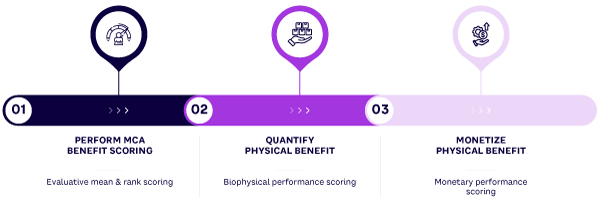
In this scenario, the MCA evaluation provides the basis for evaluation and scoring, so all indicators are considered, despite potential data and information gaps. In addition, reporting the biophysical scores separately from the monetary scores provides transparency in the quantification process, highlighting that the benefits extend beyond financial aspects to include natural systems and human well-being.
Practical Uses
There is often a disconnect between the timelines required to deliver benefits and progress toward targets and methods of economic valuation, partly because traditional cost-benefit analyses tend to value economic activities associated with direct use.13 These models may overlook avoided costs, which can bias analyses against NbS or obscure benefits like reduced human-health costs and climate change–related expenses.
Our holistic model addresses this by evaluating and documenting both use and non-use values over longer time horizons and connecting impacts to avoided costs in climate, natural, and human systems. This methodology is particularly valuable during the program development and planning phases for infrastructure projects. It can also support mobilizing commercial capital investment in NbS by showcasing their potential beneficial impacts across human, natural, and climate dimensions. Such investment mobilization may be particularly relevant for areas like water infrastructure development, in which past failures in operational and maintenance phases and longer ROI timelines have hindered commercial capital investment.14
For example, Green Climate Fund (GCF) estimates that 25% of cities (representing more than $4 trillion in economic activity) are water-stressed due to climate- and infrastructure-driven water security–related losses. Yet this reality has failed to create a compelling financial case for water-related investment.15
One of the primary barriers for this financial case is “difficulty in monetizing benefits.” As summarized in GCF’s 2022 “Water Security Sectoral Guide Consultation Version 1,” water management provides public and private sector co-benefits, but the challenge of monetizing those benefits reduces potential revenue flows and credit availability.16 A screening approach that captures benefits across economies, communities, ecosystems, and the climate addresses this barrier by showcasing value specific to the proposed project. This is particularly relevant for NbS, where cross-cutting benefits are integral to the solution.
Conclusion
Current benefit-screening valuation tools and methodologies often fall into one of two categories: either they are complex, expensive models organized as instructional guidelines for discrete quantification methods, or they are highly qualitative and subjective. By combining quantitative and qualitative methodological elements, our approach broadens the basis of value in benefit-evaluation decision-making.
By providing a comprehensive MCA framework with transparent indicators and criteria based on best and leading practices, our methodology improves transparency, captures expert knowledge, and demonstrates impacts across benefit categories. Coupling this approach with quantification and monetization of physical benefit has the potential to support holistic screening-level decision-making, facilitate identification of opportunities for impact and further inquiry, and connect to financial cost analysis in short- and long-term timelines.
This can support the evidence base for financial investment in well-designed NbS for climate change mitigation and adaptation efforts, protection of and support for biodiversity, and improvements to human well-being.
Appendix
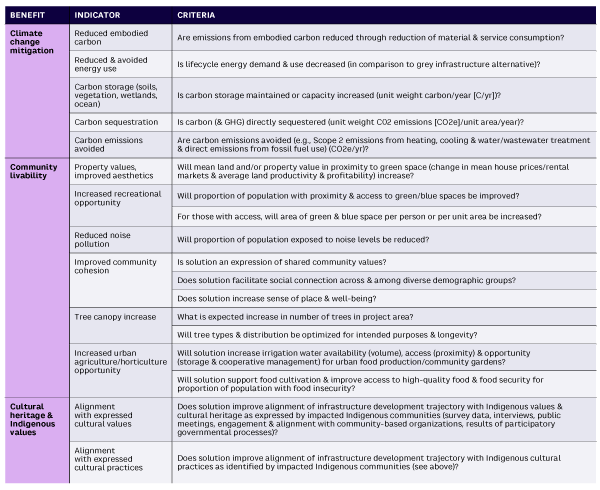
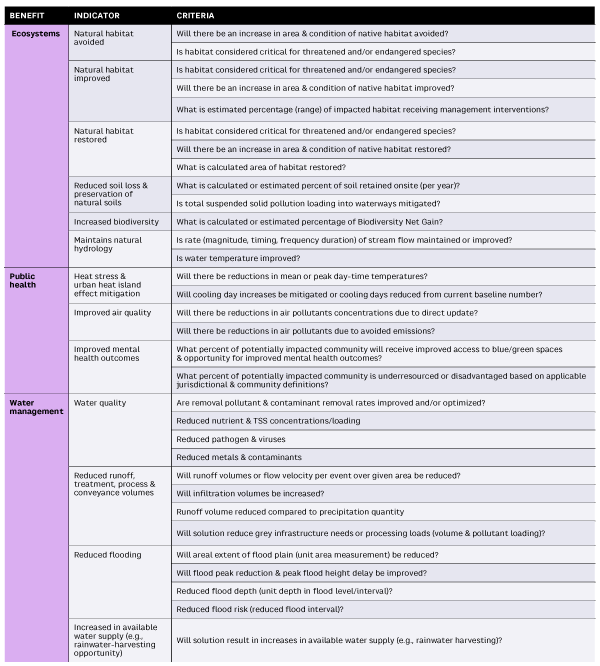
References
1 Shukla, P.R., et al. “Climate Change and Land.” IPCC, 2019.
2 Bongaarts, John. “Summary for Policymakers of the Global Assessment Report on Biodiversity and Ecosystem Services of the Intergovernmental Science-Policy Platform on Biodiversity and Ecosystem Services.” Population and Development Review, Vol. 45, No. 3, September 2019.
3 “State of Finance for Nature: The Big Nature Turnaround — Repurposing $7 Trillion to Combat Nature Loss.” United Nations Environment Programme (UNEP), December 2023.
4 Costanza, Robert, et al. “The Value of the World’s Ecosystem Services and Natural Capital.” Nature, Vol. 387, May 1997.
5 “Nature Risk Rising: Why the Crisis Engulfing Nature Matters for Business and the Economy.” World Economic Forum/PwC, January 2020.
6 “United Nations Environment Assembly Resolution 5/5: Nature-Based Solutions for Supporting Sustainable Development.” UNEP, 7 March 2022.
7 UNEP (see 3).
8 Seddon, Nathalie, et al. “Understanding the Value and Limits of Nature-Based Solutions to Climate Change and Other Global Challenges.” Philosophical Transactions of the Royal Society B: Biological Sciences, Vol. 375, No. 1794, March 2020.
9 Seddon et al. (see 8).
10 European Commission. “Evaluating the Impact of Nature-Based Solutions — A Handbook for Practitioners.” Publications Office of the European Union, 2021.
11 “Green Values Strategy Guide: Linking Green Infrastructure Benefits to Community Priorities.” Center for Neighborhood Technology (CNT), 2020.
12 “User Guide: Green Infrastructure Benefits Valuation Tool.” Earth Economics, 20 November 2018.
13 “The Value of Public Conservation Land: An Ecosystem Services Assessment.” New Zealand Institute of Economic Research (NZIER), December 2024.
14 Kolker, Joel, et al. “Financing Options for the 2030 Water Agenda.” World Bank Group, November 2016.
15 “Sectoral Guide Consultation Version 1: Water Security.” Green Climate Fund, 22 August 2022.
16 Green Climate Fund (see 15).





